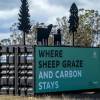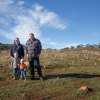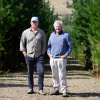
Economic return on strategically planting trees on farms is obvious
Posted 03 November 2021
Managing trees Economic benefits and markets Carbon benefits
Greenhythe, part of the Angus Stud, Landfall, started to invest in trees in a commercial capacity in the late 1990s.
Landfall director Ed Archer told Forestry Australia delegates that his father was part of a benchmarking group that looked at diversifying income streams.
“At that time, it was a lot harder to make money off livestock than it is today,” he said.
“The message that was getting pushed back then was that you needed to diversify to give yourself some financial security.”
Some plantations, including a walnut orchard, was added to the property, which signalled the start of commercial tree growing for the Archers.
The trees were strategically planted to offer distance between the neighbours to reduce the spread of disease between livestock.

Greenhythe has continued to experience the benefit of trees.
“On the back of an envelope, trees won’t compare to livestock. Especially with the way the livestock markets are at the moment,” Mr Archer said.
“But if we can integrate them, integrate the two, try and measure and put a value of the benefits of trees and the benefits they offer to the livestock, plus then the benefits of the trees themselves, the equation would come out much better.”
Mr Archer said the property had recorded an increase in marking rates on paddocks that had good shelter.
“Ewes lambing in areas that had good shelter – that’s not plantation shelter, that’s natives that we’ve fenced off - there was a 4.8% increase in marking rates.
“That works out to be a little over $85 a hectare in income. So if you put that over the life of the tree and then add the value of the timber, that’s very attractive.”
Mr Archer said there were a lot of benefits of trees integrated into farms that are hard to get solid measurements but can be observed daily.
Trees are also strategically planted in areas that are hard to manage and graze, which he hopes will be another income stream in the future.
Greenhythe has plans to plant 1000 natives per year as part of shelterbelts and improve the aesthetics of the land.

Share this Article
Latest Articles
-

17 September 2025
Celebrating excellence at the Tasmanian Timber Awards
-

17 September 2025
Forest Practices Authority Research Update Day
-

13 August 2025
Have you seen our Stems for CO2 Project signage on the Midlands Highway?
Archives
- ActivAcre hits milestone, calls for more farmers to get on board
- Napier's leading the way in sustainable forestry and carbon-neutral farming
- Sound science needed to assess carbon impacts of timber harvesting
- Newly appointed TFFPN Board of Directors
- Graduate Certificate of Forestry Scholarship
- Forestry Australia Mentoring Program 2025
- Forest Industry Roundtable planning for the long term
- Eagle Management Constraint Period extended
- Successful private native forest management celebrated
- $15 million investment in new ship loader to boost Bell Bay's forestry exports
- Standing with Tasmania's forestry industry: buy local
- TFPA: Tasmanian Freight Equalisation Scheme needs a ground-up review
- AFCA Gala Dinner celebrates industry excellence
- Fire permits now required Statewide
- Forest leaders hone skills in sustainable native regrowth management
- Tasmanian forests and the carbon market: Barriers and opportunities
- Spring is the time for fuel reduction burning
- Primed for Growth: A situation analysis of the Tasmanian Forest and Wood Products Sector
- Audit requirements cut for low-risk plantation projects
- Guidance and support for landowners after damaging winds
- Forestry Australia welcomes further definition of active forest management
- Farm & Forest Mapper Tool highlighted at Rural Youth Tasmania's Young Farmer of the Year competition
- Senate Select Committee inquiry into the Tasmanian Freight Equalisation Scheme
- Timberlink announces new wood composite products brand
- Newly developed protocol a vital tool for safeguarding forestry industry
- Red Hot Tips: Fire management for Tassie farmers
- Bioenergy: Fuelling industries with trees
- Harvesting trees: What you need to know
- Shelterbelts: How are they contributing to farm systems?
- Infill plantings and remnant vegetation: Why biodiversity depends on a thriving understory
- Plantation planning: The key to a successful plantation
- Exciting interactive forestry knowledge hub launched
- $450,000 farm forestry grant recipients revealed



